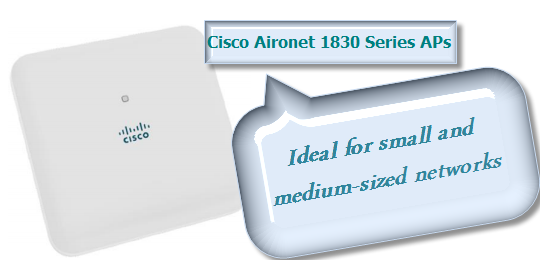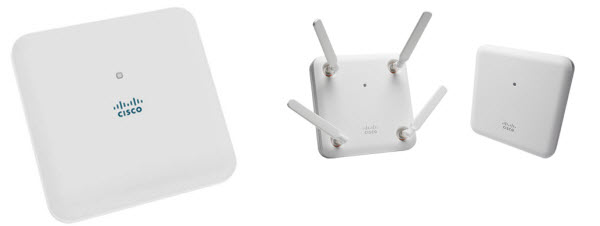
A new Cisco Aironet Access Point is coming, the Cisco Aironet 1830 Series. To support the explosion of mobile devices and today’s growing requirements of wireless networks. Recently, Cisco announced the new Aironet 1830 Series to delivers a better user experience. It is designed for small and medium-sized networks, and it will meet the growing requirements of wireless networks. Yes, the 1830 Series extends support to a new generation of Wi-Fi clients, such as smartphones, tablets, and high-performance laptops that have integrated 802.11ac Wave 1 or Wave 2 support.
What will the Aironet 1830 Series offer customers? Three main features you can read as follows:
Flexible deployment modes.
- Cisco Mobility Express Solution is an easy-to-deploy solution for up 25 access points that does not require a controller appliance
- Controller-based deployments support small and medium-sized networks that exceed 25 access points
Better Wi-Fi coverage and performance with the latest Wi-Fi technology.
- Supports 802.11ac Wave 2 (dual radio, 80 MHz channel size) and 3×3 multiple input and multiple output (MIMO)
Improved client performance with multi-user MIMO (MU-MIMO).
- Get MU-MIMO with two spatial streams for 802.11ac Wave 2 clients
- Transmit beamforming for a better client experience
Main Specifications of Cisco Aironet 1830 Series
| Key Features | Details |
| Wi-Fi standard | 802.11ac Wave 2 |
| Radios | Dual 2.4 GHz and 5 GHz, up to 80 MHz maximum bandwidth |
| Maximum PHY data rate | Total aggregate maximum data rate is 1084 Mbps
|
| MIMO radio design: spatial streams | 2.4 GHz: 3×3:2SS SU-MIMO 5 GHz: 3×3:2SS SU/MU-MIMO |
| Max. associated clients | 200 per radio, 400 maximum per access point |
| Beamforming | Transmit beamforming |
| Interfaces |
|
The New Aironet 830 Series: More Features and Benefits
With 802.11ac Wave 2, the 1830 Series provides a data rate of up to 867 Mbps on the 5-GHz radio, exceeding the data rates offered by today’s high-end 802.11n access points. It also enables a total aggregate dual-radio data rate of up to 1 Gbps, providing the necessary foundation for enterprise and service provider networks to stay ahead of the performance and bandwidth expectations and needs of their wireless users.
Due to its convenience, wireless access is increasingly the preferred form of network connectivity for corporate users. Along with this shift, there is an expectation that wireless should not slow down users’ day-to-day work, but should enable a high-performance experience while allowing users to move freely. The 1830 Series delivers industry-leading performance for highly secure and reliable wireless connections and provides a robust mobility experience that includes:
- 802.11ac Wave 2 with 3×3 multiple-input multiple-output (MIMO) technology with two spatial streams when operating in single-user or multiuser MIMO mode, offering 867-Mbps rates for more capacity and reliability than competing access points.
- Multiuser MIMO (MU-MIMO) allows transmission of data to multiple 802.11ac Wave 2 capable clients simultaneously to improve client experience. Prior to MU-MIMO, 802.11n and 802.11ac Wave 1 access points could transmit data to only one client at a time, typically referred to as single-user MIMO.
- Transmit beamforming technology improves downlink performance to mobile devices, including one- and two-spatial-stream devices on 802.11ac, while improving battery life on mobile devices such as smartphones and tablets.
- Flexible deployment mode through the Mobility Express Solution is ideal for small to medium-sized deployments that that require 25 or fewer access points. Easy setup allows the 1830 Series to be deployed on networks without a physical controller.
All of these features help ensure the best possible end-user experience on the wireless network.
The detailed Product Specifications of Cisco Aironet 1830 Series you can refer to https://www.cisco.com/c/en/us/products/collateral/wireless/aironet-1830-series-access-points/datasheet-c78-735582.html
Comparison: Aironet 1830 Series vs. Cisco 1850 Series AP
| Cisco Aironet 802.11ac G2 Series Indoor Access Points | 1830 Series | 1850 Series |
| Wi-Fi standards | 802.11 a/b/g/n/ac (Wave 2) | 802.11 a/b/g/n/ac (Wave 2) |
| Ideal for | Small or midsize enterprises | Small and midsize enterprises |
| Site type | Small, Midsize office, or warehouse | Small, Midsize office, school or warehouse |
| Application performance profile | 802.11ac migration | 802.11ac migration |
| Future-proof modularity | N/A | N/A |
| Crowded areas | ||
| Number of radios | Dual (2.4GHz and 5.0GHz) | Dual (2.4GHz and 5.0GHz) |
| Max data rate 5GHz | 867 Mbps | 1.7 Gbps |
| MIMO radio design: spatial streams | 3×3:2 MU/SU-MIMO | 4 x 4:4 (SU-MIMO), 4 x 4:3 (MU-MIMO) |
| Client count/ClientLink client count | 200/(n/a) | 200/(n/a) |
| Autonomous access point option | With Mobility Express | With Mobility Express |
| ClientLink 3.0 | Transmit Beam forming (Tx BF) | Transmit Beam forming (Tx BF) |
| CleanAir 2.0 | Spectrum Analysis* | Spectrum Analysis* |
| VideoStream | Yes | Yes |
| BandSelect | Yes | Yes |
| Rogue access point detection | Yes | Yes |
| Adaptive wireless intrusion protection system (wIPS) | Yes | Yes |
| OfficeExtend (Integrated- antenna models only) |
Yes* | |
| FlexConnect | Yes* | Yes* |
| Power | 802.3at PoE+, Enhanced PoE 802.3af (full radio functionality, disabled USB) |
802.3at PoE+, Enhanced PoE 802.3af (1852i: full radio functionality, disabled AUX & USB, 1852e: 5Ghz full radio functionality, 2.4GHz radio shifts to 2×3, disabled AUX & USB) |
| Temperature range | 0 to 40° C | 1850i: 0 to 40° C 1850e: -20 to 50° C |
| Antennas | Internal only | 1850i: Internal 1850e: External |
| Limited lifetime warranty | Yes | Yes |
*Planned for future support
More Related
NEW Cisco Aironet 1850 Series Access Points Focus on Wave 2 Wifi
Key Questions to Help you Know Cisco 802.11ac Wave 2
Migrating to Wave 2? …Definitely
Available 802.11ac APs from Cisco, Aruba, HP and Ruckus Wireless




